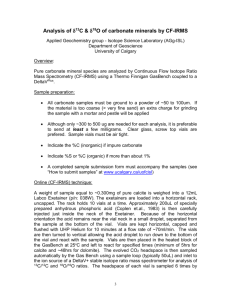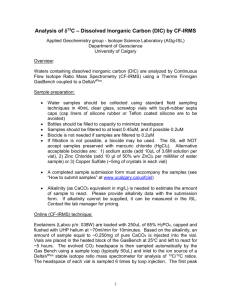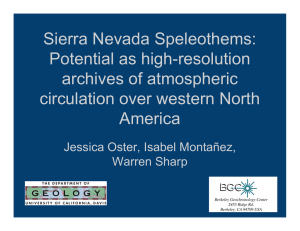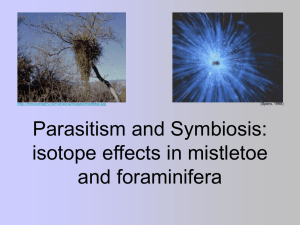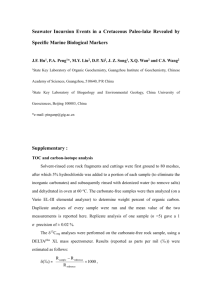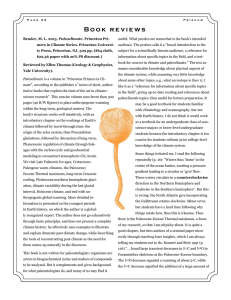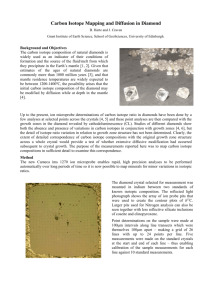Abstract
advertisement
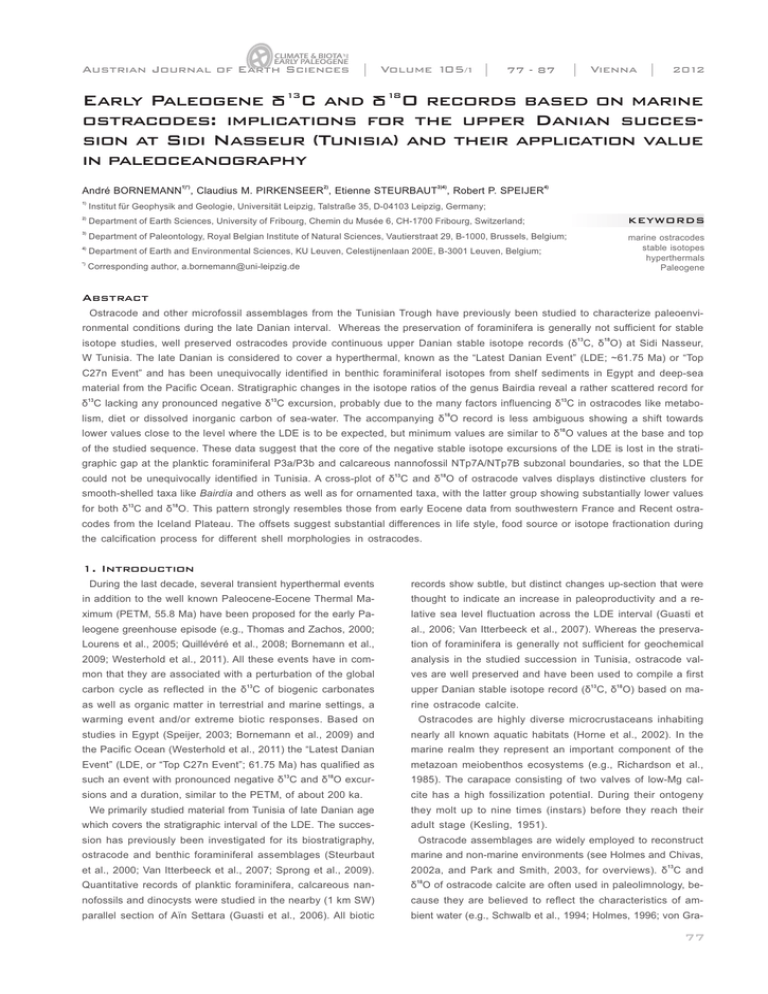
of the CLIMATE & BIOTA EARLY PALEOGENE Austrian Journal of Earth Sciences Volume 105/1 Vienna 2012 Early Paleogene o13C and o18O records based on marine ostracodes: implications for the upper Danian succession at Sidi Nasseur (Tunisia) and their application value in paleoceanography__________________________________________ André BORNEMANN1)*), Claudius M. PIRKENSEER2), Etienne STEURBAUT3)4), Robert P. SPEIJER4) 1) Institut für Geophysik and Geologie, Universität Leipzig, Talstraße 35, D-04103 Leipzig, Germany; 2) Department of Earth Sciences, University of Fribourg, Chemin du Musée 6, CH-1700 Fribourg, Switzerland; KEYWORDS 3) Department of Paleontology, Royal Belgian Institute of Natural Sciences, Vautierstraat 29, B-1000, Brussels, Belgium; 4) Department of Earth and Environmental Sciences, KU Leuven, Celestijnenlaan 200E, B-3001 Leuven, Belgium; *) Corresponding author, a.bornemann@uni-leipzig.de marine ostracodes stable isotopes hyperthermals Paleogene Abstract Ostracode and other microfossil assemblages from the Tunisian Trough have previously been studied to characterize paleoenvironmental conditions during the late Danian interval. Whereas the preservation of foraminifera is generally not sufficient for stable isotope studies, well preserved ostracodes provide continuous upper Danian stable isotope records (δ13C, δ 18O) at Sidi Nasseur, W Tunisia. The late Danian is considered to cover a hyperthermal, known as the “Latest Danian Event” (LDE; ~61.75 Ma) or “Top C27n Event” and has been unequivocally identified in benthic foraminiferal isotopes from shelf sediments in Egypt and deep-sea material from the Pacific Ocean. Stratigraphic changes in the isotope ratios of the genus Bairdia reveal a rather scattered record for δ13C lacking any pronounced negative δ13C excursion, probably due to the many factors influencing δ13C in ostracodes like metabolism, diet or dissolved inorganic carbon of sea-water. The accompanying δ18O record is less ambiguous showing a shift towards lower values close to the level where the LDE is to be expected, but minimum values are similar to δ18O values at the base and top of the studied sequence. These data suggest that the core of the negative stable isotope excursions of the LDE is lost in the stratigraphic gap at the planktic foraminiferal P3a/P3b and calcareous nannofossil NTp7A/NTp7B subzonal boundaries, so that the LDE could not be unequivocally identified in Tunisia. A cross-plot of δ13C and δ18O of ostracode valves displays distinctive clusters for smooth-shelled taxa like Bairdia and others as well as for ornamented taxa, with the latter group showing substantially lower values for both δ13C and δ18O. This pattern strongly resembles those from early Eocene data from southwestern France and Recent ostracodes from the Iceland Plateau. The offsets suggest substantial differences in life style, food source or isotope fractionation during the calcification process for different shell morphologies in ostracodes.________________________________________________ 1. Introduction During the last decade, several transient hyperthermal events records show subtle, but distinct changes up-section that were in addition to the well known Paleocene-Eocene Thermal Ma- thought to indicate an increase in paleoproductivity and a re- ximum (PETM, 55.8 Ma) have been proposed for the early Pa- lative sea level fluctuation across the LDE interval (Guasti et leogene greenhouse episode (e.g., Thomas and Zachos, 2000; al., 2006; Van Itterbeeck et al., 2007). Whereas the preserva- Lourens et al., 2005; Quillévéré et al., 2008; Bornemann et al., tion of foraminifera is generally not sufficient for geochemical 2009; Westerhold et al., 2011). All these events have in com- analysis in the studied succession in Tunisia, ostracode val- mon that they are associated with a perturbation of the global ves are well preserved and have been used to compile a first carbon cycle as reflected in the δ13C of biogenic carbonates upper Danian stable isotope record (δ C, δ O) based on ma- as well as organic matter in terrestrial and marine settings, a rine ostracode calcite._______________________________ 13 18 warming event and/or extreme biotic responses. Based on Ostracodes are highly diverse microcrustaceans inhabiting studies in Egypt (Speijer, 2003; Bornemann et al., 2009) and nearly all known aquatic habitats (Horne et al., 2002). In the the Pacific Ocean (Westerhold et al., 2011) the “Latest Danian marine realm they represent an important component of the Event” (LDE, or “Top C27n Event”; 61.75 Ma) has qualified as metazoan meiobenthos ecosystems (e.g., Richardson et al., such an event with pronounced negative δ13C and δ18O excur- 1985). The carapace consisting of two valves of low-Mg cal- sions and a duration, similar to the PETM, of about 200 ka.__ cite has a high fossilization potential. During their ontogeny We primarily studied material from Tunisia of late Danian age they molt up to nine times (instars) before they reach their which covers the stratigraphic interval of the LDE. The succes- adult stage (Kesling, 1951).__________________________ sion has previously been investigated for its biostratigraphy, Ostracode assemblages are widely employed to reconstruct ostracode and benthic foraminiferal assemblages (Steurbaut marine and non-marine environments (see Holmes and Chivas, et al., 2000; Van Itterbeeck et al., 2007; Sprong et al., 2009). 2002a, and Park and Smith, 2003, for overviews). δ13C and Quantitative records of planktic foraminifera, calcareous nan- δ18O of ostracode calcite are often used in paleolimnology, be- nofossils and dinocysts were studied in the nearby (1 km SW) cause they are believed to reflect the characteristics of am- parallel section of Aïn Settara (Guasti et al., 2006). All biotic bient water (e.g., Schwalb et al., 1994; Holmes, 1996; von Gra- Early Paleogene δ13C and δ18O records based on marine ostracodes: implications for the upper Danian succession at Sidi Nasseur (Tunisia) and their application value in paleoceanography fenstein et al., 1999; Keatings et al., 2002; Xia et al., 1997a, baut et al. (2000), and 05NSC, a partial lateral equivalent, only b). There is still ongoing research to what extent these stable 50 m south of NSF (Van Itterbeeck et al., 2007). NSF compri- isotope ratios are controlled by so called “vital effects” to ex- ses a 17 m thick interval spanning the upper part of calcare- plain isotopic disequilibria (e.g., Xia et al.,1997a, b; Holmes ous nannofossil biozone NP4, from which 42 samples were and Chivas, 2002b; Keatings et al., 2002; Li and Liu, 2010). studied. 05NSC comprises an 8 m thick interval spanning the However, all these studies are based on non-marine species, same biozone in which 21 samples were also investigated. until now only one systematic stable isotope study of marine Van Itterbeeck et al. (2007) provided a detailed biostratigraphic ostracodes has been published (Didié and Bauch, 2002), there- framework based on calcareous nannofossils, planktic and fore our understanding of stable isotope applications in paleo- benthic foraminifera for these sections (Fig. 2). The sequences ceanography based on ostracode calcite is rather poor._____ were considered to cover the Danian-Selandian boundary The principal objectives of this study are to better characte- (Steurbaut et al., 2000; Van Itterbeeck et al., 2007)(Fig. 2), 13 rize an upper Danian succession in Tunisia by employing δ C 18 and δ O analyses of ostracode calcite as well as to gain infor- but formal designation of the GSSP of the Selandian close to the base of Zone NP5 (Schmitz et al., 2011) now places the mation on the interspecific variability and ecology of the stu- studied sequences in the upper Danian. A prominent sequence died taxa. For understanding the observed interspecific isotope boundary occurs close to the P3a-P3b planktic foraminiferal patterns from Tunisia, we compared them to additional data biozone boundary probably related to a sea-level fall (Van of two early Eocene ostracode taxa from the Corbières (SW Itterbeeck et al., 2007; Steurbaut and Sztrakos, 2008; Sprong France) and a previously published dataset from the Iceland et al., 2011, 2012).__________________________________ Plateau (Didié and Bauch, 2002). Moreover, the results allow us to evaluate to what extent isotope measurements on Paleogene ostracodes can be used to reconstruct marine paleoenvironmental conditions._____________________________ 2.2 Cabano Naouto section, Corbières (SW France) 130 m of the so called ‘Blue Marls’ were accessible in the Cabano Naouto section, in the vicinity of the village Pradelles- 2. Geological setting and material en-Val. The lower part of the succession consists mainly of uniform massive dark grey marls with scarce intercalated thin 2.1 Sidi Nasseur sections (nsc, nsf) The Sidi Nasseur sections are situated near the village of sandstone beds. Above 110 m the marls become increasingly sandy, and the sandstone beds more abundant and thicker Kalaat Senan in western Tunisia close to the Algerian border until they culminate in two massive banks of several meters (Fig. 1). They are situated in the middle of a 400-m-thick Pa- thickness, representing a shift from middle neritic to coastal leocene hemipelagic sequence, which belongs to the El Haria environments. This bathymetric change is reflected in the gra- Formation (Dupuis et al., 2001). During the late Danian depo- dual shift in the microfossil assemblage composition. 127 sam- sition took place in an outer shelf environment with a water ples (PEV1-13, CN0-115) were taken from fresh in-situ marls depth of less than 200 m (Van Itterbeeck et al., 2007).______ in 1 m thickness intervals. Considering calcareous nannofos- Material from two subsections below the hill top of Sidi Nas- sils, the co-occurrence of Tribrachiatus orthostylus, Ellipsoli- seur has been used: NSF, the Sidi Nasseur section of Steur- thus macellus and Neochiastozygus rosenkrantzii, in combination with the absence of Discoaster lodoensis, indicate calcareous nannofossil zone NP 11 for all studied samples yielding ostra-codes. 3. Methods Samples were dried at 60°C and subsequently soaked in a 50 g l-1 Na2CO3 solution before being washed through a 63 µm mesh sieve. For stable isotope analyses usually two clean single valves of ostracodes were used. They were picked from the 180 to 630 µm fraction and determined either on the generic- or species-level and cleaned in distilled water using an ultrasonic bath (<45 seconds). Preservation of ostracodes was examined using an optical binocular microscope and scanning electron microscopes (SEM) at the Institute of Experimental Physics at the University of Leipzig and at the Department of Earth and Environmental Sciences at the KU Leuven. Cleaned adult valves were reacted with 100% phosphoric acid at 75°C using a Kiel III online carbonate preparation line connected to a ThermoFinnigan 252 mass spectrometer at the University of Figure 1: Locations of the studied sections._________________ Erlangen. Reproducibility was checked by replicate analysis of André BORNEMANN, Claudius M. PIRKENSEER, Etienne STEURBAUT & Robert P. SPEIJER laboratory standards and is better than ±0.05 and 0.06‰ (1σ) the Corbières section are somewhat more recrystallized. Ne- for δ13C and δ18O, respectively. All values are reported in ‰ vertheless, the overall good preservation of the analyzed Pa- relative to VPDB by assigning a δ13C value of +1.95‰ and a leogene valves lets us still expect a reliable signal of stable δ18O value of -2.20‰ to NBS19. All data shown in this paper isotopes even for δ O, which is more prone to diagenetic al- are available as an online supplement.__________________ teration than δ13C (e.g., Marshall, 1992)._________________ 4. Results and discussion 4.2 Upper Danian ostracode stable isotope records from Tunisia________________ 4.1 Preservation of ostracode valves 18 δ13C and δ18O analyses of foraminiferal calcite are widely Carbonate preservation of ostracode valves is crucial for in- used for reconstructing paleoceanographic and paleoclimatic terpreting geochemical data. Under the light microscope the condition prevailing in Cenozoic oceans (e.g., Shackleton, studied material from Tunisia shows good preservation with 1967; Kroopnick, 1985; McCorkle and Keigwin, 1994; Zachos primary pores and ornamentation, while under the SEM first et al., 2008). Stable isotopes of ostracodes are commonly signs of incipient recrystallization on the valve surface of reti- employed in paleolimnology (e.g., Schwalb et al., 1994; von culated taxa become visible (Plate 1). Ostracode valves from Grafenstein et al., 1999) and sometimes on fossil material since the Paleozoic (e.g., Janz and Vennemann, 2005; Toth et al., 2010; Bennett et al., 2011), whereas systematic stable isotope studies on marine taxa are rare (Mazzini et al., 1999; Didié and Bauch, 2002). In contrast to foraminifera, whose isotope signals represent an average of their full ontogeny, cal- Figure 2: δ average. 13 C and δ18O records of Bairdia from the upper Danian of the Sidi Nasseur sequence in Tunisia. Thick line represents a 3-point moving Early Paleogene δ13C and δ18O records based on marine ostracodes: implications for the upper Danian succession at Sidi Nasseur (Tunisia) and their application value in paleoceanography cification of ostracode valves is a rapid process, which often ges on sub-tropical shelf sections caused by high amplitude takes place within a few hours or days (Turpen and Angell, changes in the evaporation-precipitation or diagenetic altera- 1971). Therefore the ostracode isotope signal provides only tion of the calcareous tests (mainly thick-shelled nodosarians; a snap-shot of the prevailing paleoceanographic conditions Schmitz et al., 1996; Bornemann et al., 2009).____________ and multiple single-specimen measurements exhibit a much 13 The δ C Bairdia data fluctuate between -1.6 and 0.5‰ with higher natural variability than benthic foraminifera._________ a high variability of >1‰ within a sample, therefore no convin- In order to document stratigraphic changes of δ13C and δ 18O cing negative δ13C excursion is apparent in our record from during the late Danian in Tunisia we compiled a continuous Sidi Nasseur (Fig. 2). One likely reason might be that the par- mono-generic Bairdia record. Hyperthermal events like the ticular event level is not preserved in the studied succession, PETM are usually characterized by a pronounced negative since the P3a/P3b boundary is located close to an unconfor- δ13C excursion related to the injection of isotopically light car- mity that coincides with two different biozonal boundaries (Fig. bon into the ocean-atmosphere system and transient warming 2; Van Itterbeeck et al., 2007; Steurbaut and Sztrakos, 2008). as reflected in the δ18O of various carbonate-bearing archives Alternatively the δ13C record may strongly be biased by so or other temperature-controlled proxies like Mg/Ca or TEX86 called “vital effects” that obscured any primary environmental (e.g., Dickens et al., 1995; Zachos et al., 2006; Sluijs et al., signal. These vital effects are well known for ostracodes and 2007). A negative δ13C excursion by up to 2‰ for the LDE, are caused by a metabolic control of carbon isotope fractiona- which is situated close to the P3a-P3b planktic foraminiferal tion, differences in diet, change in δ 13C DIC or even different boundary and NTp7a-NTp7b nannofossil boundary, has been modes of calcification. Moreover, it has to be considered that documented in several Egyptian sections, in Zumaia (Spain) ostracode carapaces represent a very short-time interval, as and possibly at the Wombat Plateau (see compilation by molting takes place within hours or days (Turpen and Angell, Bornemann et al., 2009). In addition, Westerhold et al. (2011) 1971). The Sidi Nasseur succession represents subtropical were able to show at a deep-sea site in the Pacific Ocean shelf deposits. In such a setting the hydrographic conditions that this event is associated with a negative 0.5‰ shift in δ18O are largely controlled by seasonal changes in primary produc- of benthic foraminiferal calcite indicating a slight bottom water tivity and evaporation-precipitation. This may also cause an warming of ~2-3°C. However, such evidence for warming has increased variability of the data compared to foraminiferal cal- not been observed before in sediments from the southern Te- cite records from southern Tethyan margin._______________ thyan margin as discussed by Bornemann et al. (2009) nei- The δ18O data range from -0.9 to 0.4‰ with a <0.6‰ varia- ther for the LDE nor for the more severe PETM (Schmitz et bility within a sample and exhibit a maximum just below the al., 1996). This may be due to the highly variable δ18O chan- P3a-P3b boundary, which is followed by a 1‰ shift to lower Figure 3: δ sections. 13 C -δ18O cross plots of the Danian ostracode samples from Tunisia. (A) Selected samples, (B) all analyses from the NSF and NSC André BORNEMANN, Claudius M. PIRKENSEER, Etienne STEURBAUT & Robert P. SPEIJER values across this boundary (Fig. 2). For comparison deep- ter comprises smooth-shelled taxa like Bairdia showing relati- sea benthic foraminiferal values vary from 0.6‰ to 0.8‰ (Za- vely high isotope values for both δ C and δ O with a range 13 18 13 chos et al., 2008; Westerhold et al., 2011) indicating cooler between -2 and 0.4‰ for δ C, and between -1 and 0.5‰ for deep-sea temperatures as expected. It is well known that the δ18O (Fig. 3B). Other smooth and usually thinner shelled taxa ostracode carapace calcite is not precipitated in equilibrium like Parakrithe, Paracypris or Cytherella display similar δ13C with the ambient water. This is expressed in a substantial po- values as Bairdia, although their δ18O values are on average sitive deviation from equilibrium values (Holmes and Chivas, about 1‰ lower. The second cluster is made up by sculptured 2002b), so the real difference might have been >2‰ larger taxa like Mauritsina, Ordoniya and Paracosta (amongst others) suggesting reasonable >10°C warmer temperatures for the show much lower values ranging from -6.2‰ to -3‰ for δ13C Tunisian shelf compared to the deep-ocean. However, the and from -1.7‰ to -0.7‰ for δ18O (Fig. 3B)._______________ 18 δ O data are believed to display a constant species-specific Very similar patterns are observed in the lower Eocene data offset and a strong correlation with temperature and δ18O of from the Corbières section (SW France) and in modern data the ambient water mass (e.g., Xia et al., 1997a; Didié and from the Iceland Plateau by Didié and Bauch (2002; Fig. 4), Bauch, 2002; Chivas et al., 2002; Li and Liu, 2010). If these suggesting that the general isotopic offset between smooth δ18O changes reflect primary signals, then an increase in bot- and ornamented taxa is a common feature in Cenozoic oceans. tom water temperature or seasonally enhanced freshwater In the Corbières the heavily ornamented taxon Horrificiella input are possible explanations for the observed shift. A war- aculeata (δ13C: -6 to -4‰; δ18O: -3.8 to -2.3‰) shows subs- ming of bottom water temperature would support the hypothe- tantially lower values than the smooth shelled Bairdia crebra sis that the LDE is representing an early Cenozoic hyperther- (δ13C: 0 to 1.7‰; δ18O: 1.6 to 2.9‰). The latter are on average mal, however, as pointed out above the low temporal samp- about 1.2‰ higher with respect to δ18O and 6‰ for δ13C than ling resolution and the existence of an unconformity at the Horrificiella (Fig. 4A).________________________________ P3a/P3b boundary makes it difficult to confirm this hypothesis. At the Iceland Plateau, Didié and Bauch (2002) observed an Moreover, similar negative values are recorded near the base offset with respect to both δ13C and δ18O between the smooth- and the top of the section. δ18O variations at this frequency shelled Krithe and the sculptured Henryhowella, with the latter have not been described before for this time interval, so their showing lower values for both isotope systems compared to relevance to climate change during the LDE remains unclear. Krithe (Fig. 4B). This shift cannot be explained by their microhabitat since Krithe is usually viewed as an endobenthic taxon 4.3 Further implications for Paleogene ostracode analyses________________________ Henryhowella. Didié and Bauch (2002) also argued that diffe- δ13C-δ18O cross plots of all studied ostracode taxa consisting rences in diet, metabolism and processes controlling calcifica- of a wide range of morphologies reveal two clearly separated tion might be responsible for this shift. In addition, Keatings et and should thereby display lower δ13C values than epibenthic clusters independent of whether the data are plotted sample- al. (2002) discussed the presence of slightly acidic conditions wise or as the complete data set (Fig. 3A and B). The first clus- in the inner lamellae of ostracode valves during calcification Figure 4: (A) δ 13 C -δ18O cross plots of ostracodes from the lower Eocene succession of the Corbières section (SW France) and (B) an ostracode– benthic foraminifera comparison from surface sediments recovered from the Iceland Plateau (Didié and Bauch, 2002). The dotted greyish lines in (B) represent the δ18O of equilibrium calcite (horizontal line) and the δ13C of dissolved inorganic carbon (vertical line) according to Didié and Bauch (2002).__ Early Paleogene δ13C and δ18O records based on marine ostracodes: implications for the upper Danian succession at Sidi Nasseur (Tunisia) and their application value in paleoceanography in order to explain δ 18O disequilibria.____________________ succession. These changes may indicate a warming of The δ13C differences between the analysed groups of up to bottom water temperatures or an increase in freshwater 7‰ are difficult to explain by different microhabitats and a re- supply onto the southern Tethyan shelf. No clear trend for sulting pore water gradient. Even additional secondary calcite δ C through time has been observed, probably due to a 13 or incipient recrystallization of reticulated and ornamented dominant metabolic control._________________________ ostracode valves are unlikely the cause of these consistently Both datasets from Tunisia and France display a promi- large offsets. Furthermore, our data suggest that this diffe- nent pattern with significantly lower isotope values for orna- rence is more pronounced in the fossil material (2 to 7‰), mented ostracodes compared to smooth taxa like Bairdia, compared with only ~1‰ in the Nordic Sea (Didié and Bauch, a pattern that is also apparent in modern ostracodes from 2002). Possible explanations for this discrepancy are different the Iceland Plateau, albeit less pronounced. Feasible ex- oceanographic conditions in the Paleogene, including a stron- planations are differences in the metabolic controlled iso- ger fractionation with respect to δ 13C in Paleogene oceans tope fractionation, particularly for δ13C, or different mecha- probably due to a more efficient biological carbon pump, or nisms of calcification including a kinetic fractionation. Due differences in diet.___________________________________ to the low number of stable isotope studies on Recent ma- Another potential factor attributing to these offsets could be rine ostracodes the factors controlling δ13C and δ18O in os- a (species-specific) kinetic fractionation effect leading to the tracode calcite are only poorly understood so far, limiting depletion of the heavier isotope species as previously obser- the application of stable isotopes in microhabitat recon- ved in asymbiotic planktic foraminifera and corals (McCon- structions and paleoceanography.___________________ naughey, 1989; Spero and Lea, 1996). The latter could also be typical for rapid calcification processes in ostracodes. Until Acknowledgements now the rapidness of calcite precipitation and the factors con- This manuscript benefited from the constructive reviews of trolling ostracode size and calcification particularly of marine Benjamin Sames and one anonymous reviewer. M. Joachimski taxa are poorly documented. However, results from culture (University of Erlangen) is thanked for stable isotope analyses experiments of non-marine ostracodes suggest increased os- and J. Lenzner (University of Leipzig) helped with the SEM. tracode growth rates, calcification and shortened intermolting Jimmy Van Itterbeeck kindly provided the selected ostracodes times at higher temperatures (e.g., Martens, 1985; Mezquita from Tunisia. Financial support for this project was provided by et al., 1999; Li and Liu, 2010)._________________________ FWO and KU Leuven Research Fund to RPS.____________ This would imply that smooth valved taxa are less affected by kinetic fractionation probably due to slower calcification during their molting and calcification phase than ornamented ostracodes, or alternatively simply by different modes of calcifi- References cation (Keyser and Walter, 2004). A complex system of calcifi- Bennett, C.E., Williams, M., Leng, M.J., Siveter, D.J., Davies, cation processes has been reported by Yamada et al. (2005), S.J., Sloane, H.J. and Wilkinson, I.P., 2011. Diagenesis of fos- specifically regarding the formation of ridges of the marine os- sil ostracods: Implications for stable isotope based palaeoen- tracode taxon Semicytherura. The observation that the forma- vironmental reconstruction. Palaeogeography Palaeoclimato- tion of ornamentation is different from smooth-valved ostraco- logy Palaeoecology, 305, 150-161.______________________ des might be also one possible explanation for the clustering. We can conclude that there are numerous unresolved problems in interpreting δ13C and δ18O of marine ostracode calcite, specifically in past shelf sediments without any information about Berggren, W.A. and Pearson, P.N., 2005. A revised tropical to subtropical Paleogene planktonic foraminiferal zonation. Journal of Foraminiferal Research, 35, 279-298.______________ the isotopic composition of sea-water. Studies under control- Bornemann, A., Schulte, P., Sprong, J., Steurbaut, E., Youssef, led or monitored conditions on marine taxa are indispensible M. and Speijer, R.P., 2009. Latest Danian carbon isotope ano- to improve our understanding on the prospects and limits of maly and associated environmental change in the southern stable isotope application of marine ostracode calcite.______ Tethys (Nile Basin, Egypt). Journal of the Geological Society, 166, 1135-1142. 5. Conclusions The study of δ13C and δ18O of marine ostracode valves from Chivas, A.R., De Deckker, P., Wang, S.X. and Cali, J.A., 2002. the Paleogene revealed the following results:_____________ Oxygen-isotope systematics of the nektic ostracod Australo- The existence of a hiatus at the P3a/P3b subzonal boun- cypris robusta. Geophysical Monograph, 131, 301-313.______ dary and the low temporal resolution inhibits the unequivo- Dickens, G.R., O'Neil, J.R., Rea, D.K. and Owen, R.M., 1995. cal localisation of the Latest Danian Event close to this le- Dissociation of oceanic methane hydrate as a cause of the vel. Despite these issues distinctive δ 18O changes have carbon-isotope excursion at the end of the Paleocene. Paleo- been observed in a Bairdia record during the upper Danian ceanography, 10, 965-971.____________________________ in Tunisia. Moreover, a previously not reported negative shift occurs in the lower part of the studied sedimentary André BORNEMANN, Claudius M. PIRKENSEER, Etienne STEURBAUT & Robert P. SPEIJER Didié, C. and Bauch, H.A., 2002. Implications of upper Qua- Li, X.Z. and Liu, W.G., 2010. Oxygen isotope fractionation in ternary stable isotope records of marine ostracodes and ben- the ostracod Eucypris mareotica: Results from a culture expe- thic formaminifers for paleoecological and paleoceanographi- riment and implications for paleoclimate reconstruction. Jour- cal investigations. Geophysical Monograph, 131, 279-299.___ nal of Paleolimnology, 43, 111-120._____________________ Dupuis, C., Steurbaut, E., Molina, E., Rauscher, R., Tribovil- Lourens, L.J., Sluijs, A., Kroon, D., Zachos, J.C., Thomas, E., lard, N., Arenillas, I., Arz, J.A., Robaszynski, F., Caron, M., Rohl, U., Bowles, J. and Raffi, I., 2005. Astronomical pacing Robin, E., Rocchia, R. and Lefevre, I., 2001. The Cretaceous- of late Palaeocene to early Eocene global warming events. Palaeogene (K/ P) boundary in the Ain Settara section (Kalaat Nature, 435, 1083-1087.______________________________ Senan, central Tunisia); lithological, micropalaeontological and geochemical evidence. Bulletin de l'Institut Royal des Sciences Naturelles de Belgique - Sciences de la Terre, 71, 169-190. Guasti, E., Speijer, R.P., Brinkhuis, H., Smit, J. and Steurbaut, E., 2006. Paleoenvironmental change at the Danian-Selandian transition in Tunisia: Foraminifera, organic-walled dinoflagellate Marshall, J.D., 1992. Climatic and oceanographic isotopic signals from the carbonate rock record and their preservation. Geological Magazine, 129, 143-160.____________________ Martens, K., 1985. Effects of temperature and salinity on postembryonic growth in Mytilocypris henricae (Chapman) (Crustacea, Ostracoda). Journal of Crustacean Biology, 5, 258-272. cyst and calcareous nannofossil records. Marine Micropaleon- Martini, E., 1971. Standard Tertiary and Quaternary calcare- tology, 59, 210-229. ous nannoplankton zonation. In: A. Farinacci (ed.), Procee- Holmes, J. and Chivas, A.R., 2002a. The ostracoda: applications in Quaternary research. American Geophysical Union, Washington, DC. 313 pp._____________________________ Holmes, J.A., 1996. Trace-element and stable-isotope geochemistry of non-marine ostracod shells in Quaternary palaeoenvironmental reconstruction. Journal of Paleolimnology, 15, 223235. Holmes, J.A. and Chivas, A.R., 2002b. Ostracod shell chemistry - overview. Geophysical Monograph, 131, 185-204.___ Horne, D.J., Cohen, A. and Martens, K., 2002. Taxonomy, morphology and biology of Quaternary and living Ostracoda. Geophysical Monograph, 131, 5-36._____________________ Janz, H. and Vennemann, T.W., 2005. Isotopic composition (O, C, Sr, and Nd) and trace element ratios (Sr/Ca, Mg/Ca) of Miocene marine and brackish ostracods from North Alpine Foreland deposits (Germany and Austria) as indicators for palaeoclimate. Palaeogeography Palaeoclimatology Palaeoecology, 225, 216-247._______________________________ Keatings, K.W., Heaton, T.H.E. and Holmes, J.A., 2002. Carbon and oxygen isotope fractionation in non-marine ostracods: Results from a 'natural culture' environment. Geochimica et Cosmochimica Acta, 66, 1701-1711.____________________ Kesling, R.V., 1951. Morphology of ostracod molt stages. Illinois biological monographs, 21, 1-126.__________________ Keyser, D. and Walter, R., 2004. Calcification in ostracodes. Revista Espanola de Micropaleontologia, 36, 1-11._________ 13 Kroopnick, P.M., 1985. The Distribution of C of ΣCO2 in the World Oceans. Deep-Sea Research Part A, 32, 57-84.______ dings of the 2nd Planktonic Conference, Rome, 1970. Edizioni Tecnoscienza, Rome, pp. 739-785._____________________ Mazzini, I., Anadon, P., Barbieri, M., Castorina, F., Ferreli, L., Gliozzi, E., Mola, M. and Vittori, E., 1999. Late Quaternary sea-level changes along the Tyrrhenian coast near Orbetello (Tuscany, central Italy): Palaeoenvironmental reconstruction using ostracods. Marine Micropaleontology, 37, 289-311.____ McConnaughey, T., 1989. 13 C and 18 O isotopic disequilibrium in biological carbonates: 1. Patterns. Geochimica et Cosmochimica Acta, 53, 151-162.____________________________ 13 McCorkle, D.C. and Keigwin, L.D., 1994. Depth profiles of δ C in bottom water and core top C. wuellerstorfi on the Ontong Java Plateau and Emperor Seamounts. Paleoceanography, 9, 197-208. Mezquita, F., Roca, J.R. and Wansard, G., 1999. Moulting, survival and calcification: the effects of temperature and water chemistry on an ostracod crustacean (Herpetocypris intermedia) under experimental conditions. Archiv für Hydrobiologie, 146, 219-238. Park, L.E. and Smith, A.J., 2003. Bridging the gap: Trends in ostracode biological and geological sciences, Papers. The Paleontological Society, New Haven, CT, pp. 290.____________ Quillévéré, F., Norris, R.D., Kroon, D. and Wilson, P.A., 2008. Transient ocean warming and shifts in carbon reservoirs during the early Danian. Earth and Planetary Science Letters, 265, 600-615. Richardson, M.D., Briggs, K.B. and Young, D.K., 1985. Effects of biological-activity by abyssal benthic macroinvertebrates on a sedimentary structure in the Venezuela Basin. Marine Geology, 68, 243-267. Early Paleogene δ13C and δ18O records based on marine ostracodes: implications for the upper Danian succession at Sidi Nasseur (Tunisia) and their application value in paleoceanography Schmitz, B., Speijer, R.P. and Aubry, M.P., 1996. Latest Pale- Sprong, J., Kouwenhoven, T.J., Bornemann, A., Schulte, P., ocene benthic extinction event on the southern Tethyan shelf Stassen, P., Steurbaut, E., Youssef, M. and Speijer, R.P., (Egypt): Foraminiferal stable isotopic (δ 13 C, δ 18 O) records. 2012. Characterization of the Latest Danian Event by means Geology, 24, 347-350. of benthic foraminiferal assemblages along a depth transect Schmitz, B., Pujalte, V., Molina, E., Monechi, S., Orue-Etxebarria, X., Speijer, R.P., Alegret, L., Apellaniz, E., Arenillas, I., at the southern Tethyan margin (Nile Basin, Egypt). Marine Micropaleontology, 86-87, 15-31._______________________ Aubry, M.P., Baceta, J.I., Berggren, W.A., Bernaola, G., Cabal- Steurbaut, E. and Sztrakos, K., 2008. Danian/Selandian boun- lero, F., Clemmensen, A., Dinares-Turell, J., Dupuis, C., Heil- dary criteria and North Sea Basin-Tethys correlations based mann-Clausen, C., Orus, A.H., Knox, R., Martin-Rubio, M., Ortiz, on calcareous nannofossil and foraminiferal trends in SW S., Payros, A., Petrizzo, M.R., Von Salis, K., Sprong, J., Steur- France. Marine Micropaleontology, 67, 1-29.______________ baut, E. and Thomsen, E., 2011. The Global Stratotype Sections and Points for the bases of the Selandian (Middle Paleocene) and Thanetian (Upper Paleocene) stages at Zumaia, Spain. Episodes, 34, 220-243._________________________ Schwalb, A., Lister, G.S. and Kelts, K., 1994. Ostracode carbonate δ18O- and δ13C-signature of hydrological and climatic changes affecting Lake Neuchâtel, Switzerland, since the latest Pleistocene. Journal of Paleolimnology, 11, 3-17.______ Shackleton, N., 1967. Oxygen isotope analyses and Pleistocene temperatures re-assessed. Nature, 215, 15-16._______ Steurbaut, E., Dupuis, C., Arenillas, I., Molina, E. and Matmati, M.F., 2000. The Kalaat Senan section in central Tunisia: A potential reference section for the Danian/Selandian boundary. GFF, 122, 158-160. Thomas, E. and Zachos, J.C., 2000. Was the late Paleocene thermal maximum a unique event? GFF, 122, 169-170._____ Toth, E., Gorog, A., Lecuyer, C., Moissette, P., Balter, V. and Monostori, M., 2010. Palaeoenvironmental reconstruction of the Sarmatian (Middle Miocene) Central Paratethys based on palaeontological and geochernical analyses of foraminifera, Sluijs, A., Bowen, G.J., Brinkhuis, H., Lourens, L.J. and Tho- ostracods, gastropods and rodents. Geological Magazine, mas, E., 2007. The Palaeocene-Eocene Thermal Maximum 147, 299-314. super greenhouse: Biotic and geochemical signatures, age models and mechanisms of global change. In: M. Williams, A.M. Haywood, F.J. Gregory and D.N. Schmidt (eds.), Deeptime perspectives on climate change - Marrying the signal from computer models and biological proxies. Geological Society, London, pp. 323-349.___________________________ Speijer, R.P., 2003. Danian-Selandian sea-level change and biotic excursion on the southern Tethyan margin (Egypt). In: Turpen, J.B. and Angell, R.W., 1971. Aspects of molting and calcification in ostracod Heterocypris. Biological Bulletin, 140, 331-338. Van Itterbeeck, J., Sprong, J., Dupuis, C., Speijer, R.P. and Steurbaut, E., 2007. Danian/Selandian boundary stratigraphy, paleoenvironment and Ostracoda from Sidi Nasseur, Tunisia. Marine Micropaleontology, 62, 211-234._________________ S.L. Wing, P.D. Gingerich, B. Schmitz and E. Thomas (eds.), Varol, O., 1989. Palaeocene calcareous nannofossil biostrati- Causes and Consequences of Globally Warm Climates in the graphy. In: J.A. Crux and S.E. Van Heck (eds.), Nannofossils Early Paleogene. Geological Society of America Special Pa- and their Applications. Ellis Horwood, Chichester, pp. 267-310. per, 369, pp. 275-290._______________________________ von Grafenstein, U., Erlernkeuser, H. and Trimborn, P., 1999. Spero, H.J. and Lea, D.W., 1996. Experimental determination Oxygen and carbon isotopes in modern fresh-water ostracod of stable isotope variability in Globigerina bulloides: Implica- valves: assessing vital offsets and autecological effects of in- tions for paleoceanographic reconstructions. Marine Micropa- terest for palaeoclimate studies. Palaeogeography Palaeocli- leontology, 28, 231-246.______________________________ matology Palaeoecology, 148, 133-152._________________ Sprong, J., Speijer, R.P. and Steurbaut, E., 2009. Biostratigra- Westerhold, T., Röhl, U., Donner, B., McCarren, H.K. and phy of the Danian/Selandian transition in the southern Tethys. Zachos, J.C., 2011. A complete high-resolution Paleocene Special reference to the Lowest Occurrence of planktic fora- benthic stable isotope record for the central Pacific (ODP Site minifera Igorina albeari. Geologica Acta, 7, 63-77._________ 1209). Paleoceanography, 26, doi: 10.1029/2010PA002092._ Sprong, J., Youssef, M.A., Bornemann, A., Schulte, P., Steur- Xia, J., Ito, E. and Engstrom, D.R., 1997a. Geochemistry of baut, E., Stassen, P., Kouwenhoven, T.J. and Speijer, R.P., ostracode calcite: 1. An experimental determination of oxygen 2011. A multi-proxy record of the Latest Danian Event at Ge- isotope fractionation. Geochimica et Cosmochimica Acta, 61, bel Qreiya, Eastern Desert, Egypt. Journal of Micropalaeonto- 377-382. logy, 30, 167-182.___________________________________ André BORNEMANN, Claudius M. PIRKENSEER, Etienne STEURBAUT & Robert P. SPEIJER Xia, J., Engstrom, D.R. and Ito, E., 1997b. Geochemistry of ostracode calcite: 2. The effects of water chemistry and seasonal temperature variation on Candona rawsoni. Geochimica et Cosmochimica Acta, 61, 383-391.____________________ Yamada, S., Tsukagoshi, A. and Ikeya, N., 2005. Carapace formation of the podocopid ostracode Semicytherura species (Crustacea: Ostracoda). Lethaia, 38, 323-332.____________ Zachos, J.C., Dickens, G.R. and Zeebe, R.E., 2008. An early Cenozoic perspective on greenhouse warming and carboncycle dynamics. Nature, 451, 279-283.__________________ Zachos, J.C., Schouten, S., Bohaty, S., Quattlebaum, T., Sluijs, A., Brinkhuis, H., Gibbs, S.J. and Bralower, T.J., 2006. Extreme warming of mid-latitude coastal ocean during the Paleocene-Eocene Thermal Maximum: Inferences from TEX 86 and isotope data. Geology, 34, 737-740._________________ Received: 13 October 2011 Accepted: 14 March 2012 André BORNEMANN1)*), Claudius M. PIRKENSEER2), Etienne STEURBAUT3)4), Robert P. SPEIJER4)____________________ 1) Institut für Geophysik and Geologie, Universität Leipzig, Talstraße 35, D-04103 Leipzig, Germany;______________________________ 2) Department of Earth Sciences, University of Fribourg, Chemin du Musée 6, CH-1700 Fribourg, Switzerland;_____________________ 3) Department of Paleontology, Royal Belgian Institute of Natural Sciences, Vautierstraat 29, B-1000, Brussels, Belgium;_____________ 4) Department of Earth and Environmental Sciences, KU Leuven, Celestijnenlaan 200E, B-3001 Leuven, Belgium;__________________ *) Corresponding author, a.bornemann@uni-leipzig.de______________ Early Paleogene δ13C and δ18O records based on marine ostracodes: implications for the upper Danian succession at Sidi Nasseur (Tunisia) and their application value in paleoceanography Plate 1: Scanning electron microscope images showing important taxa studied herein and document their state of preservation. Figure A: Bairdia septentrionalis (adult, left valve; Tunisia, sample NSF 8.5, upper-most Danian); Figure B: close up of (A); Figure C: Paracosta parakefensis (adult, right valve; Tunisia, NSF 8.5, uppermost Danian); Figure D: close up of (C); Figure E: Bairdia crebra (adult carapace, right valve view; Corbières, lower Eocene); Figure F: Horrificiella aculeata (adult, female, right valve, Corbières, lower Eocene); André BORNEMANN, Claudius M. PIRKENSEER, Etienne STEURBAUT & Robert P. SPEIJER
